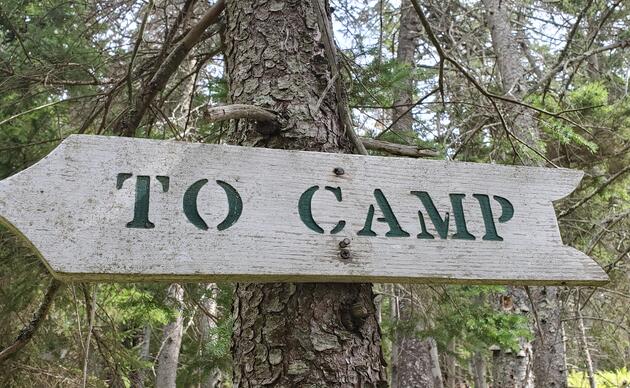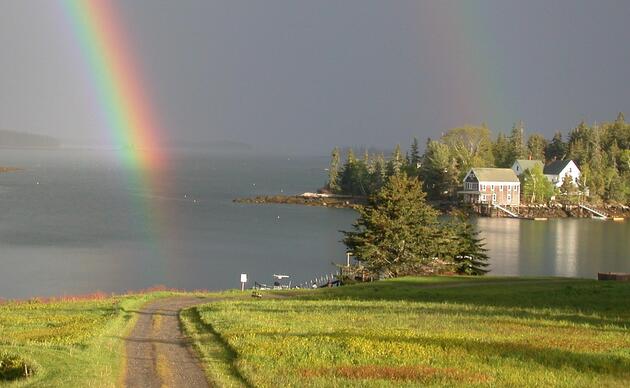Todd Wildlife Sanctuary
Located six miles southeast of Damariscotta on Muscongus Bay, Todd Audubon Sanctuary includes a 30-acre mainland parcel as well as 330-acre Hog Island, located a quarter-mile offshore and home to the Audubon Camp in Maine.
Explore Hog Island
Visitors on foot are welcome on both the mainland and island property any time dawn to dusk, seven days a week, year-round. No dogs, bikes or offroad vehicles. Please note that there are no public ferries to Hog Island. Visitors are allowed to beach small vessels on the island, but there are no public boat launches on the mainland. Moorings are available on a first-come, first-serve basis. No fees are collected for mooring boats and no responsibilty is assumed by Audubon for use of moorings.
Habitat
The mainland portion of Todd Audubon Sanctuary features second-growth spruce and fir with mixed oak and large white pines. The diversity of trees along with understory shrubs such as huckleberry and blueberry provide habitat for thrushes, nuthatches, and several species of warblers, including Blackburnian, yellow-rumped, and black-throated green. Cavity trees are habitat for woodpeckers, raccoons, and flying squirrels. Other mammals include red fox, deer, and a variety of rodents. Low-light forest plants such as Canada mayflower, bunchberry, starflower, pink lady slipper, and hair-cap moss can be found among the stands of mature spruce.
Maintained for both habitat diversity and views of Muscongus Bay, the sanctuary’s meadows are filled with milkweed, goldenrod, and a variety of ferns. Home to green frogs and sunfish, a small pond is routinely visited by a variety of birds.
Common eider, black guillemot, osprey, and double crested cormorant can often be seen from the shore of the sanctuary. Tidal habitats teem with crabs, mussels, sea stars, and periwinkles among the rockweed.
Hog Island is dominated by white and red spruce, white pine, and birch trees. Hay-scented fern “balds,” or clearings, can be found on the island’s southern tip. More than 150 bird species have been identified on the island, several of which breed there.
Trails
- Hockomock Point Trail (1 mile) Beginning at the visitor’s center, the Hockomock Point Trail is an easy, one-hour interpretive walk through meadows, woods—including spruce and red oak—and along granite ledges, stone walls and the shore of Muscongus Bay.
- Pinetree Trail (.5 mile) Beginning just below the pond on the road to the boathouse, the Pine Tree Trail is an easy 25-minute interpretive walk that traverses a meadow and winds through a hardwood forest dotted with several large white pine trees.
- Meadow Trail (.5 mile) Beginning below the visitor’s center by the trailhead of the Hockomock Point Trail, the gentle, picturesque Meadow Trail reveals superb stands of milkweed—which attract monarch butterflies—as well as abundant insect life and other botanical interests.
- Hog Island Trail (5 miles) Visitors to Hog Island may walk the five-mile trail around the perimeter of Hog Island and explore shorter island trails.
History
Todd Wildlife Sanctuary has a long history of human use. Attracted by the area’s abundant clam beds, the Abanaki people fished on Hog Island and Hockomock Point for many thousands of years. In the late 1600s and into the 1700s, European settlers cut the timber from the shorelands and established farms, pulling rocks from the fields and piling them into the walls that exist to this day. Hog Island is one of many Maine coast islands that bears the name of the livestock that roamed its new-world pastures.
The establishment of Todd Wildlife Sanctuary was made possible through the inspiration of Mabel Loomis Todd, who purchased Hog Island to save it from logging in 1908. Following her mother’s death in 1932, Millicent Todd Bingham worked to preserve the island and establish the ecology camp in concert with Audubon in 1936.
A decade and a half after Hog Island was given to Audubon, Dr. Carl Bucheister, then director of the camp, arranged for the purchase of 30 mainland acres from Charles Nash, a farmer whose family had occupied the nearby mainland point from before 1900. In 2000 the sanctuary was transferred to Maine Audubon, and in 2009 management was transferred back to National Audubon. All programs on Hog Island and care of the mainland sanctuary are now administered by the Seabird Restoration Program (Project Puffin) of the National Audubon Society. To this day the sanctuary and Hog Island Audubon Camp continue to provide people from all parts of the country with opportunities to experience and learn about nature on the coast of Maine.
Directions
Address: 12 Audubon Road, Bremen, Maine 04551.
From the south: From U.S. Route 1, exit onto Business Route 1 and drive through Damariscotta. After 1.6 miles, turn right onto Biscay Road at the traffic light at McDonald’s. After 5.1 miles turn left onto Route 32 at the ‘T’ intersection. After 1.4 miles turn right onto Keene Neck Road. The sanctuary is 1.6 miles down at the end of the road.
From the north: From U.S. Route 1 in Waldoboro, turn left (south) onto Route 32. After 7.6 miles turn left onto Keene Neck Road. The sanctuary is 1.6 miles down at the end of the road.
For a detailed map of the camp buildings and mainland area, click on the photo below



